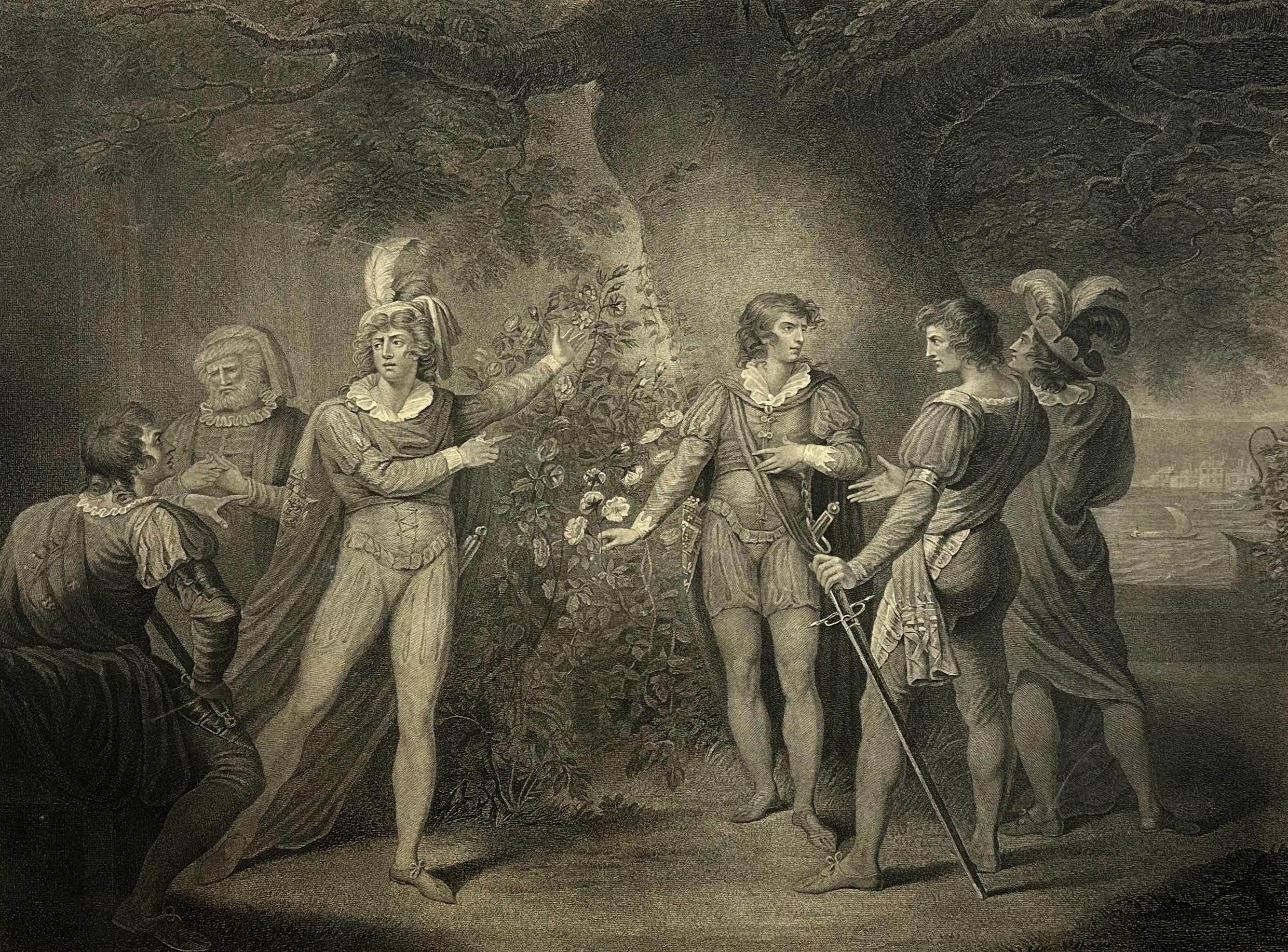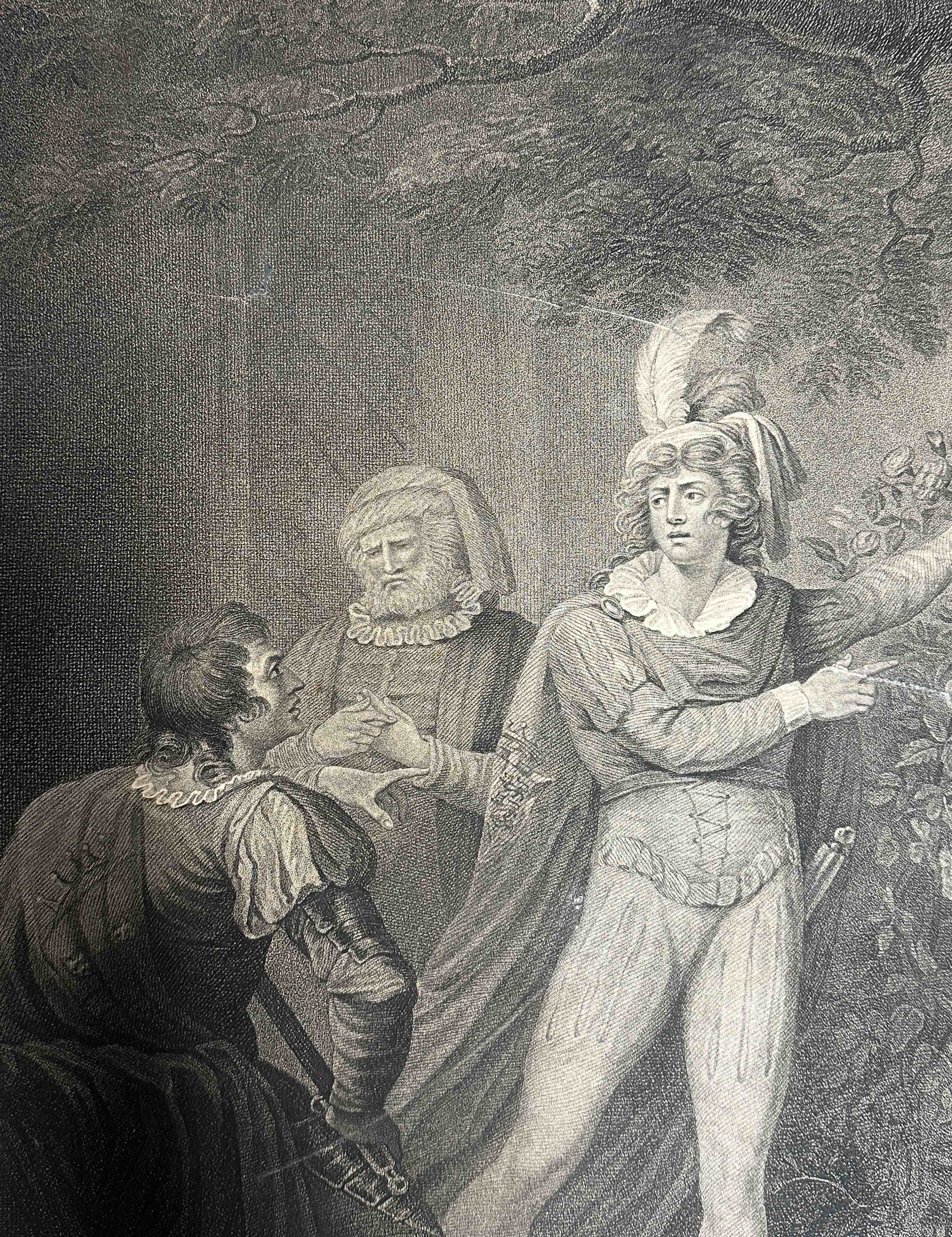



Shakespeare's Henry VI, Act II, Scene IV
Artist: John Boydell
Price:
$400.00
Medium: Prints


More Details
Creation Date: 1793
Materials: ink on paper
Dimensions: 23" x 30" x 1"
Condition: Condition of image is very good despite two thin scratches (see enclosed close ups) and a few barely visible pin point nicks; glue stains in outer margin beyond plate impression not affecting image or inner margin; paper age toned.
Finish: Unframed
About the Item: Engraving by J. Ogborne depicting Shakespeare's Henry VI, Act II, Scene IV after the painting by John Boydell. Published 1793 by John and Josiah Boydell, Shakespeare Gallery, London. Image measures 17 in x 23.25 in. Paper measures 22.5 in x 29.5 in.
John Boydell (1720 – 1804) was an English publisher noted for his reproductions of engravings. He helped alter the trade imbalance between Britain and France in engravings and initiated an English tradition in the art form. A former engraver himself, Boydell promoted the interests of artists as well as patrons and as a result his business prospered.
Boydell apprenticed himself to William Henry Toms, an artist he admired, and learned engraving. He established his own business in 1746 and published his first book of engravings around the same time. Boydell did not think much of his own artistic efforts and eventually started buying the works of others, becoming a print dealer as well as an artist. He became a successful importer of French prints during the 1750s but was frustrated by their refusal to trade prints in kind. To spark reciprocal trade, he commissioned William Wollett's spectacular engraving of Richard Wilson's The Destruction of the Children of Niobe, which revolutionised the print trade. Ten years later, largely as a result of Boydell's initiative, the trade imbalance had shifted, and he was named a fellow of the Royal Society for his efforts.
In the 1790s, Boydell began a large Shakespeare venture that included the establishment of a Shakespeare Gallery, the publication of an illustrated edition of Shakespeare's plays, and the release of a folio of prints depicting scenes from Shakespeare's works. Some of the most illustrious painters of the day contributed, such as Benjamin West and Henry Fuseli.
Throughout his life, Boydell dedicated time to civic projects: he donated art to government institutions and ran for public office. In 1790 he became Lord Mayor of London. The French Revolutionary Wars led to a cessation in Continental trade at the end of the 1790s. Without this business, Boydell's firm declined and he was almost bankrupt at his death in 1804.
John Boydell (1720 – 1804) was an English publisher noted for his reproductions of engravings. He helped alter the trade imbalance between Britain and France in engravings and initiated an English tradition in the art form. A former engraver himself, Boydell promoted the interests of artists as well as patrons and as a result his business prospered.
Boydell apprenticed himself to William Henry Toms, an artist he admired, and learned engraving. He established his own business in 1746 and published his first book of engravings around the same time. Boydell did not think much of his own artistic efforts and eventually started buying the works of others, becoming a print dealer as well as an artist. He became a successful importer of French prints during the 1750s but was frustrated by their refusal to trade prints in kind. To spark reciprocal trade, he commissioned William Wollett's spectacular engraving of Richard Wilson's The Destruction of the Children of Niobe, which revolutionised the print trade. Ten years later, largely as a result of Boydell's initiative, the trade imbalance had shifted, and he was named a fellow of the Royal Society for his efforts.
In the 1790s, Boydell began a large Shakespeare venture that included the establishment of a Shakespeare Gallery, the publication of an illustrated edition of Shakespeare's plays, and the release of a folio of prints depicting scenes from Shakespeare's works. Some of the most illustrious painters of the day contributed, such as Benjamin West and Henry Fuseli.
Throughout his life, Boydell dedicated time to civic projects: he donated art to government institutions and ran for public office. In 1790 he became Lord Mayor of London. The French Revolutionary Wars led to a cessation in Continental trade at the end of the 1790s. Without this business, Boydell's firm declined and he was almost bankrupt at his death in 1804.

About The Artist
John Boydell (1720-1802) was an English engraver, print publisher, art dealer and politician. Born in Dorrington, England, he was a land surveyor's son and was supposed to follow in his father's footsteps; hence, he was skilled in drawing and sketching. Boydell, however, chose another path and became an apprentice to an engraver, William Henry Toms. He was apprenticed for seven years before publishing his first volume of printed views of England and Wales in 1748. In 1752, he opened a print shop in Cheapside. Boydell later purchased old plates, imported prints, and sold works of art in several European countries, including France, Holland, Germany, and Italy. In 1789, he opened his Shakespeare Gallery in Pall Mall, and the first set of engravings based on paintings exhibited in the gallery was issued in 1791. Many leading artists exhibited at the venue. Later in life, he sustained severe financial losses due to the French Revolution and was forced to dispose of his Shakespeare Gallery by lottery. He became an alderman of the City of London and eventually the Lord Mayor of London.
More Galleries to Explore





![HILL LANDSCAPE WITH TREES [Signed]](https://d19sv06ke5lbyb.cloudfront.net/worker/items/21822-hill-landscape-with-trees-signed.jpg?format=auto&width=390&height=300)
![RIVER AND MOUNTAINS LANDSCAPE [Signed]](https://d19sv06ke5lbyb.cloudfront.net/worker/items/21833-river-and-mountains-landscape-signed.jpg?format=auto&width=390&height=300)
![PARIS VIRGINIA LANDSCAPE [Signed]](https://d19sv06ke5lbyb.cloudfront.net/worker/items/21797-paris-virginia-landscape-signed.jpg?format=auto&width=387&height=300)
![SHORELINE LANDSCAPE WITH ROCKS [Signed]](https://d19sv06ke5lbyb.cloudfront.net/worker/items/21832-shoreline-landscape-with-rocks-signed.jpg?format=auto&width=380&height=300)
![JAPANESE COURTESAN [Signed]](https://d19sv06ke5lbyb.cloudfront.net/worker/items/21812-japanese-courtesan-signed.jpg?format=auto&width=229&height=300)




 Facebook
Facebook
 Twitter
Twitter
 Email
Email







![HILL LANDSCAPE WITH TREES [Signed]](https://d19sv06ke5lbyb.cloudfront.net/worker/items/21822-hill-landscape-with-trees-signed.jpg?format=auto&width=300&height=231)
![RIVER AND MOUNTAINS LANDSCAPE [Signed]](https://d19sv06ke5lbyb.cloudfront.net/worker/items/21833-river-and-mountains-landscape-signed.jpg?format=auto&width=300&height=232)
![PARIS VIRGINIA LANDSCAPE [Signed]](https://d19sv06ke5lbyb.cloudfront.net/worker/items/21797-paris-virginia-landscape-signed.jpg?format=auto&width=300&height=234)








